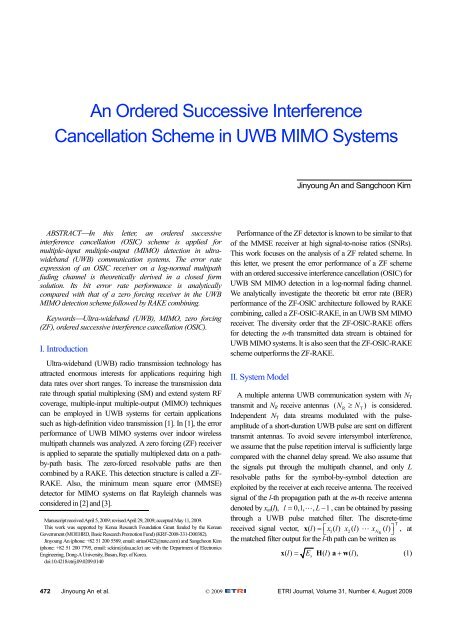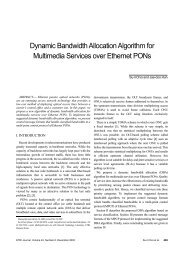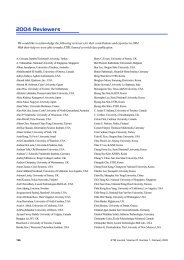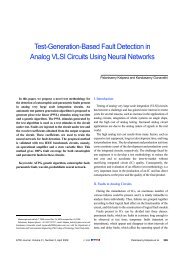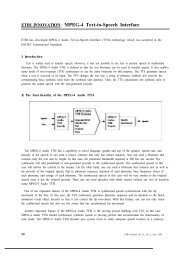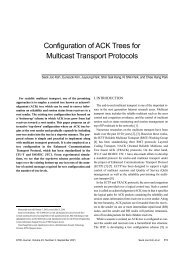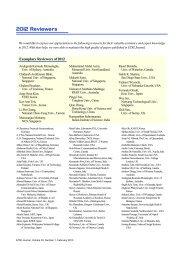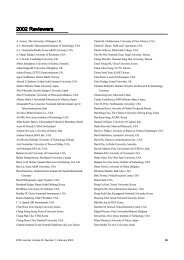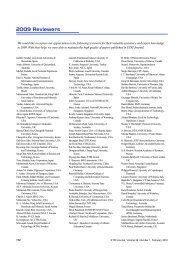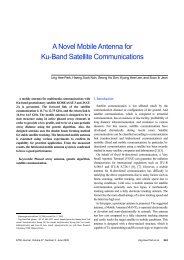An Ordered Successive Interference Cancellation ... - ETRI Journal
An Ordered Successive Interference Cancellation ... - ETRI Journal
An Ordered Successive Interference Cancellation ... - ETRI Journal
You also want an ePaper? Increase the reach of your titles
YUMPU automatically turns print PDFs into web optimized ePapers that Google loves.
<strong>An</strong> <strong>Ordered</strong> <strong>Successive</strong> <strong>Interference</strong><br />
<strong>Cancellation</strong> Scheme in UWB MIMO Systems<br />
Jinyoung <strong>An</strong> and Sangchoon Kim<br />
ABSTRACT⎯In this letter, an ordered successive<br />
interference cancellation (OSIC) scheme is applied for<br />
multiple-input multiple-output (MIMO) detection in ultrawideband<br />
(UWB) communication systems. The error rate<br />
expression of an OSIC receiver on a log-normal multipath<br />
fading channel is theoretically derived in a closed form<br />
solution. Its bit error rate performance is analytically<br />
compared with that of a zero forcing receiver in the UWB<br />
MIMO detection scheme followed by RAKE combining.<br />
Keywords⎯Ultra-wideband (UWB), MIMO, zero forcing<br />
(ZF), ordered successive interference cancellation (OSIC).<br />
I. Introduction<br />
Ultra-wideband (UWB) radio transmission technology has<br />
attracted enormous interests for applications requiring high<br />
data rates over short ranges. To increase the transmission data<br />
rate through spatial multiplexing (SM) and extend system RF<br />
coverage, multiple-input multiple-output (MIMO) techniques<br />
can be employed in UWB systems for certain applications<br />
such as high-definition video transmission [1]. In [1], the error<br />
performance of UWB MIMO systems over indoor wireless<br />
multipath channels was analyzed. A zero forcing (ZF) receiver<br />
is applied to separate the spatially multiplexed data on a pathby-path<br />
basis. The zero-forced resolvable paths are then<br />
combined by a RAKE. This detection structure is called a ZF-<br />
RAKE. Also, the minimum mean square error (MMSE)<br />
detector for MIMO systems on flat Rayleigh channels was<br />
considered in [2] and [3].<br />
Manuscript received April 5, 2009; revised April 29, 2009; accepted May 11, 2009.<br />
This work was supported by Korea Research Foundation Grant funded by the Korean<br />
Government (MOEHRD, Basic Research Promotion Fund) (KRF-2008-331-D00382).<br />
Jinyoung <strong>An</strong> (phone: +82 51 200 5589, email: sirius0422@nate.com) and Sangchoon Kim<br />
(phone: +82 51 200 7795, email: sckim@dau.ac.kr) are with the Department of Electronics<br />
Engineering, Dong-A University, Busan, Rep. of Korea.<br />
doi:10.4218/etrij.09.0209.0140<br />
Performance of the ZF detector is known to be similar to that<br />
of the MMSE receiver at high signal-to-noise ratios (SNRs).<br />
This work focuses on the analysis of a ZF related scheme. In<br />
this letter, we present the error performance of a ZF scheme<br />
with an ordered successive interference cancellation (OSIC) for<br />
UWB SM MIMO detection in a log-normal fading channel.<br />
We analytically investigate the theoretic bit error rate (BER)<br />
performance of the ZF-OSIC architecture followed by RAKE<br />
combining, called a ZF-OSIC-RAKE, in an UWB SM MIMO<br />
receiver. The diversity order that the ZF-OSIC-RAKE offers<br />
for detecting the n-th transmitted data stream is obtained for<br />
UWB MIMO systems. It is also seen that the ZF-OSIC-RAKE<br />
scheme outperforms the ZF-RAKE.<br />
II. System Model<br />
A multiple antenna UWB communication system with N T<br />
transmit and N R receive antennas ( NR ≥ NT)<br />
is considered.<br />
Independent N T data streams modulated with the pulseamplitude<br />
of a short-duration UWB pulse are sent on different<br />
transmit antennas. To avoid severe intersymbol interference,<br />
we assume that the pulse repetition interval is sufficiently large<br />
compared with the channel delay spread. We also assume that<br />
the signals put through the multipath channel, and only L<br />
resolvable paths for the symbol-by-symbol detection are<br />
exploited by the receiver at each receive antenna. The received<br />
signal of the l-th propagation path at the m-th receive antenna<br />
denoted by x m (l), l = 0,1, , L−1<br />
, can be obtained by passing<br />
through a UWB pulse matched filter. The discrete-time<br />
T<br />
received signal vector, x() l = ⎡ ⎣<br />
x1() l x2() l xN<br />
() l ⎤ ,<br />
R ⎦<br />
at<br />
the matched filter output for the l-th path can be written as<br />
x() l = E H() l a+<br />
w (), l<br />
(1)<br />
s<br />
472 Jinyoung <strong>An</strong> et al. © 2009 <strong>ETRI</strong> <strong>Journal</strong>, Volume 31, Number 4, August 2009
where E s is the average symbol energy. Here, the information<br />
symbol vector over N T transmit antennas is denoted by<br />
T<br />
a=<br />
[ a1 a2a N<br />
] , where a<br />
T<br />
n is an information symbol from the<br />
n-th transmit antenna. The received noise vector is represented<br />
T<br />
by w() l = ⎡ ⎣<br />
w1() l w2() l wN<br />
() l ⎤ ,<br />
R ⎦<br />
where w m (l) is a real<br />
zero-mean white Gaussian noise of variance N 0 /2. For the l-th<br />
delayed path, an N R ×N T discrete-time channel matrix H(l) can<br />
be expressed as H() l = ⎡ ⎣<br />
h1() l h2() l hN<br />
() l ⎤<br />
T ⎦<br />
where the column<br />
T<br />
vector h n (l) is given as hn() l = ⎡ ⎣<br />
h1 n() l h2n() l hN () .<br />
Rn<br />
l ⎤ ⎦<br />
Here,<br />
h mn (l), m= 1, 2, , NR<br />
, n= 1, 2, , NT<br />
, is the channel coefficient<br />
of the l-th path for the signal from the n-th transmit antenna to<br />
the m-th receive antenna. It is given by hmn () l = ζ<br />
mn<br />
() l gmn<br />
() l<br />
[4], where ζ () l mn<br />
∈ { ± 1}<br />
with equal probability is a discrete<br />
random variable (RV) representing pulse-phase inversion, and<br />
g mn (l) is the fading magnitude term with a log-normal<br />
distribution.<br />
III. <strong>Ordered</strong> <strong>Successive</strong> <strong>Interference</strong> <strong>Cancellation</strong><br />
In the ZF-RAKE examined in [1], ZF detection is<br />
performed by the filter matrix F ZF (l)=H(l) + , where<br />
() ⋅<br />
+<br />
denotes the pseudoinverse. The output signal vector,<br />
T<br />
y() l = ⎡ ⎣<br />
y1() l y2() l yN<br />
() l ⎤ ,<br />
R ⎦<br />
for the l-th path of a<br />
particular bit is given by y(l)=F ZF (l)x(l). The decision variable<br />
(DV) of the MRC output for a particular bit of the n-th<br />
transmitted data stream can be written as<br />
L−1 2<br />
n<br />
α<br />
l = 0 n n<br />
z = ∑ () l y (), l<br />
(2)<br />
where α<br />
2 n() l = 1 υn()<br />
l and υ () () H<br />
n<br />
l = ⎡ ⎣<br />
H l H () l ⎤ ⎦<br />
. Here,<br />
nn<br />
() ⋅<br />
H<br />
is the conjugate transpose. The diversity order of an<br />
(N R , N T , L) MIMO system based on the ZF-RAKE scheme is<br />
given by the parameter D ZF =L(N R –N T +1).<br />
In a ZF-RAKE, a bank of separate filters has been<br />
considered to estimate the N T data substreams. However, the<br />
output of one of the filters can be exploited to help the<br />
operation of the others. In the OSIC technique [5], the signal<br />
with the highest post-detection SNR is first chosen for<br />
processing and then cancelled from the overall received signal<br />
vector. This reduces the burden of inter-channel interference on<br />
the receivers of the remaining data substreams. To apply OSIC<br />
to the ZF-RAKE architecture for multipath channels, the OSIC<br />
procedure for each path is performed prior to RAKE<br />
combining. The zero-forced signal is first obtained in the<br />
detection step of each propagation path signal. Then, the zeroforced<br />
signals are combined to detect each substream. This<br />
detection scheme is called a ZF-OSIC-RAKE. The OSIC<br />
algorithm for the l-th path signal is shown in Fig. 1. Here,<br />
−1<br />
for i = 1, 2, ,<br />
N<br />
F<br />
k l<br />
T<br />
+<br />
ZF, i( l) = Hi( l)<br />
( j)<br />
2<br />
i( ) = arg min fi<br />
( l)<br />
j<br />
( ki<br />
( l))<br />
yk ()( ) ( ) ( )<br />
i l<br />
l = fi l xil<br />
xi+<br />
1<br />
( l) = xi( l) −hk ( )( )<br />
( )( )<br />
i l<br />
l ⋅Quan⎡yk i l<br />
l ⎤<br />
⎣ ⎦<br />
ki<br />
() l<br />
Hi+<br />
1( l) = Hi<br />
( l)<br />
end<br />
T<br />
⎛<br />
⎞<br />
Permutate the elements of y( l) ⎜= ⎡ yk 1() l( l) yk2() l( l) yk ()( )<br />
N l<br />
l ⎤<br />
⎟<br />
R<br />
⎝ ⎣<br />
⎦ ⎠<br />
according to the original sequence ( 1, 2, , NT<br />
).<br />
Fig. 1. ZF-OSIC algorithm for each path in ZF-OSIC-RAKE.<br />
( i(), l<br />
ZF, i(), l<br />
i()<br />
l )<br />
H F x denotes the specific variables in the i-th<br />
detection step. Initial values are set to be H 1<br />
() l = H (), l<br />
( j<br />
FZF,1() l = FZF (), l x1() l = x();<br />
l f ) i<br />
() l and Quan[ i ] indicate<br />
the row j of F ZF, i()( l = H<br />
i() l + ) and quantization operation,<br />
()<br />
respectively; and () k i l<br />
H l H () l depicts the nulling of<br />
i+ 1<br />
=<br />
column k i (l) of the channel matrix H i (l).<br />
To obtain the single zero-forced signal of the l-th path signal<br />
in OSIC step i, the row of F ZF, i (l) with the minimal norm is<br />
chosen. After getting the zero-forced signal vector associated<br />
with each multipath component, we reorder the elements of the<br />
zero-forced vector according to the original sequence of the<br />
transmitted data streams. Then, RAKE combining of the zeroforced<br />
signals is accomplished to detect each data stream and<br />
leads to obtaining a DV for each transmitted data stream. The<br />
DV of the RAKE combiner output for a particular bit of the<br />
n-th transmitted data stream can be written as (2).<br />
The instantaneous SNR γ n<br />
of the DV of the RAKE<br />
combiner output for a particular bit of the n-th data stream is<br />
i<br />
L − 1 2<br />
given by γn<br />
= 2 λ∑ α ( )<br />
l 0 n<br />
l with λ = E<br />
=<br />
s<br />
N0<br />
. By<br />
following an analysis similar to that in [1], we obtain the<br />
quadratic form, α 2 () () H<br />
n<br />
l = hn l Sn() l h<br />
n()<br />
l , where S n (l) is a<br />
N R ×N R non-negative Hermitian matrix constructed from<br />
hn+ 1(), l hn+<br />
2(), l , hN<br />
() l . Then, γ<br />
T<br />
n<br />
can be expressed as<br />
LNR 2<br />
( n) ( n)<br />
γn = 2λ∑ λ<br />
i 1 i<br />
q<br />
= i<br />
= 2λ γ ′<br />
n<br />
, where q ( n)<br />
i<br />
and λ ( n)<br />
i<br />
,<br />
respectively, are the zero-mean unit-variance Gaussian RV and<br />
eigenvalue of the matrix Sn= diag [ Sn(0) Sn(1) Sn( L−1) ].<br />
Thus, the eigenvalues of S n (l) with NR − NT<br />
+ n are equal<br />
to 1, and the others with N T –n eigenvalues are 0. Hence, the<br />
matrix S n has LN R eigenvalues, among which the L(N R –N T +n)<br />
eigenvalues are equal to 1, and the other L(N T –n) eigenvalues<br />
L( NR− N 2<br />
T+<br />
n) ( n)<br />
are equal to 0; therefore, γ ′<br />
n<br />
= ∑ q<br />
i=<br />
0<br />
i<br />
. The<br />
variable γ ′ is a central chi-square distributed RV with<br />
n<br />
( n)<br />
D<br />
ZF-OSIC<br />
=<br />
R T<br />
L( N − N + n)<br />
degrees of freedom, which has a<br />
probability density function (PDF) of<br />
κ<br />
κ−1 −t<br />
2<br />
( κ )<br />
f ′ () t = 0.5 Γ ( ) t e , (3)<br />
γ n<br />
<strong>ETRI</strong> <strong>Journal</strong>, Volume 31, Number 4, August 2009 Jinyoung <strong>An</strong> et al. 473
( n)<br />
where κ = 0.5 D<br />
ZF-OSIC<br />
, and Γ⋅ () is the gamma function<br />
∞<br />
b−1<br />
−<br />
defined as Γ ( b)<br />
=∫ τ e τ dτ<br />
, b > 0 . Thus, by averaging<br />
0<br />
(<br />
P n)<br />
() t = Q 2λt<br />
over the PDF<br />
the conditional BER<br />
r ( )<br />
fγ () t<br />
n′<br />
, the average BER for a particular bit of the n-th<br />
transmitted data stream over log-normal fading channels can be<br />
calculated as<br />
( n) ∞<br />
( n)<br />
b,ZF-OSIC<br />
0<br />
r<br />
P = ∫ P () t f () t dt. (4)<br />
To derive the average BER in a closed form, a tightly<br />
approximated expression of Q-function such as Q( β )<br />
−β2 2 −2β2<br />
3<br />
(1 12) e + (1 6) e [2] is employed. Then, the<br />
conditional BER, given λ = Es<br />
N0<br />
, can be approximated as<br />
γ n′<br />
− λ<br />
( ) + ( )<br />
P () t 112 e 16 e . (5)<br />
( n) t − 4λ<br />
t 3<br />
r<br />
By using (3) and (5) in (4), the average BER for the ZF-OSIC-<br />
RAKE expressed in a closed form can be obtained as<br />
( κ − )<br />
( ) ( )<br />
( κ − )<br />
( ) ( )<br />
1! 1!<br />
. (6)<br />
12 2λ + 1 Γ κ 6 (8/ 3) λ+ 1 Γ κ<br />
( n)<br />
Pb<br />
,ZF-OSIC<br />
+<br />
κ κ<br />
Here, ()! ⋅ is the factorial defined as s! = s⋅( s−1) 2⋅1.<br />
The average BER over all N T data streams can be given by<br />
( 1 )<br />
NT ( n)<br />
ZF-OSIC T n=<br />
1 b,ZF-OSIC<br />
BER = N ∑ P . Note that to obtain the<br />
theoretical performance of the ZF-RAKE, the same formula as<br />
that of ZF-OSIC-RAKE can be used except κ = 0.5 D .<br />
IV. Simulation Results<br />
Consider the binary PAM scheme (E s =E b ). In the simulations,<br />
the SNR per bit in decibels is defined as η<br />
b<br />
=<br />
2 λ (dB) + 10log<br />
10<br />
L( NR − NT<br />
+ 1) for (N R , N T , L) systems.<br />
The log-normal fading amplitude g(l) can be expressed as<br />
() l<br />
g()<br />
l = e ψ , where ψ () l is a Gaussian RV with mean μ<br />
ψ () l<br />
2<br />
and variance σ<br />
ψ<br />
. We assume that the standard deviation of<br />
20log<br />
10<br />
g( l) = ψ ( l) ( 20log10<br />
e)<br />
is 5 dB. To satisfy<br />
2<br />
Egl [ ( ) ] = e −ρ<br />
l representing the average power of path l,<br />
2<br />
μψ() l<br />
=−σψ<br />
−ρl<br />
2 is required, where σ ψ<br />
is obtained as<br />
σ<br />
ψ<br />
= 5 ( 20log10<br />
e)<br />
. Here, the power decay factor ρ = 0 is<br />
used. The receiver is assumed to have perfect knowledge of the<br />
channel fading coefficients of L resolvable paths. In the figures,<br />
theoretic and simulated BER curves of the UWB MIMO<br />
system are shown with lines and markers, respectively.<br />
For a (4, 3, L) MIMO system, Fig. 2(a) shows the analytical<br />
and simulated BERs of the ZF-RAKE and ZF-OSIC-RAKE<br />
as a function of SNR per bit in decibels. The analytical results<br />
are similar to the simulated BER performance and demonstrate<br />
the performance boost in using the ZF-OSIC-RAKE over the<br />
ZF-RAKE. This boost in BER performance comes from a<br />
ZF<br />
BER<br />
10 0<br />
10 -1<br />
10 -2<br />
10 -3<br />
10 -4<br />
ZF (4, 3, 2)<br />
ZF-OSIC (4, 3, 2)<br />
ZF (4, 3, 4)<br />
ZF-OSIC (4, 3, 4)<br />
ZF (4, 3, 8)<br />
ZF-OSIC (4, 3, 8)<br />
0 2 4 6 8 10 12<br />
SNR per bit (dB)<br />
(a)<br />
BER<br />
0 2 4 6 8 10 12<br />
SNR per bit (dB)<br />
(b)<br />
Fig. 2. BER vs. SNR for different values of (a) L and (b) N R .<br />
10 0<br />
10 -1<br />
10 -2<br />
10 -3<br />
10 -4<br />
ZF (4, 4, 4)<br />
ZF-OSIC (4, 4, 4)<br />
ZF (5, 4, 4)<br />
ZF-OSIC (5, 4, 4)<br />
ZF (6, 4, 4)<br />
ZF-OSIC (6, 4, 4)<br />
power gain due to the increase of diversity order in each<br />
increasing cancellation step. Also, multipath combining yields<br />
enhanced performance in both ZF-OSIC-RAKE and ZF-<br />
RAKE. In an (N R , 4, 4) case, Fig. 2(b) shows the analytical and<br />
simulated results of BER as a function of SNR per bit for<br />
various N R . The increase in N R increases the diversity order of<br />
the ZF-OSIC-RAKE receiver as well as that of the ZF-RAKE.<br />
V. Conclusion<br />
The error performance of a UWB MIMO system over indoor<br />
log-normal fading channels has been analyzed. The UWB<br />
MIMO receiver employs ZF-OSIC detectors and then a RAKE<br />
temporal combiner. It has been shown that the ZF-OSIC for<br />
detecting the n-th transmitted data stream in an (N R , N T , L)<br />
MIMO system achieves a diversity order of L(N R –N T +n). The<br />
ZF-OSIC offers better performance than the ZF receiver.<br />
References<br />
[1] H. Liu, R.C. Qiu, and Z. Tian, “Error Performance of Pulse-Based<br />
Ultra-Wideband MIMO Systems over Indoor Wireless<br />
Channels,” IEEE Trans. Wireless Commun., vol. 4, no. 6, Nov.<br />
2005, pp. 2939-2944.<br />
[2] N. Kim, Y. Lee, and H. Park, “Performance <strong>An</strong>alysis of MIMO<br />
System with Linear MMSE Receiver,” IEEE Trans. Wireless<br />
Commun., vol. 7, no. 11, Nov. 2008, pp. 4474-4478.<br />
[3] A. Zanella, M. Chiani, and M.Z. Win, “MMSE Reception and<br />
<strong>Successive</strong> <strong>Interference</strong> <strong>Cancellation</strong> for MIMO Systems with<br />
High Spectral Efficiency,” IEEE Trans. Wireless Commun., vol. 4,<br />
no. 3, May 2005, pp. 1244-1253<br />
[4] A.F. Molish, J.R. Foerster, and M. Pendergrass, “Channel Models<br />
for Ultra-Wideband Personal Area Network,” IEEE Wireless<br />
Commun., vol. 10, no. 6, Dec. 2003, pp. 14-21.<br />
[5] P.W. Wolniansky et al., “V-BLAST: <strong>An</strong> Architecture for<br />
Realizing Very High Data Rates Over the Rich-Scattering<br />
Wireless Channel,” Proc. IEEE ISSSE, Sept. 1998, pp. 295-300.<br />
474 Jinyoung <strong>An</strong> et al. <strong>ETRI</strong> <strong>Journal</strong>, Volume 31, Number 4, August 2009


